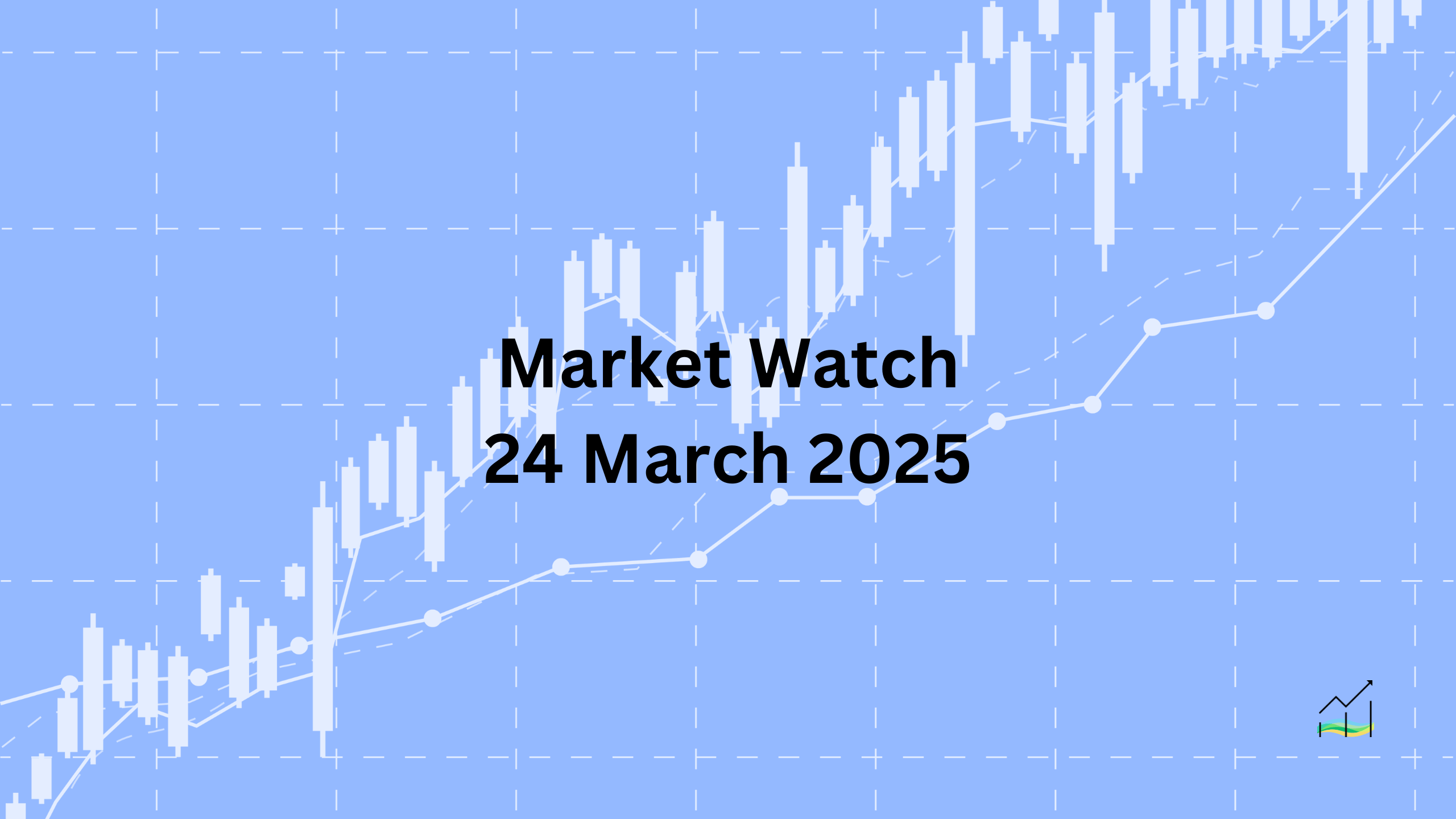24/03/2025 Market Watch

Markets Stabilize as Trade Tensions Ease
Investors are experiencing cautious relief after recent signals from senior U.S. officials suggested a moderation in trade tensions. The previously heightened threat of reciprocal and sector-specific tariffs, set to begin on April 2, now appears less severe, with discussions leaning toward more selective applications and possible exemptions. However, uncertainty remains due to conflicting messages from the relatively new U.S. administration.
In currency markets, the U.S. dollar opened the week slightly weaker against most G10 currencies, particularly the Japanese yen. This follows a notable drop in Japan’s composite PMI, an event that unusually influenced market sentiment. Conversely, U.S. Treasury yields have strengthened, with the 10-year yield rising to approximately 4.28%, marking its highest level in about a week. Emerging market currencies showed mixed performance amid these developments.
Stock markets globally presented a mostly positive outlook. Despite declines in Japan and Taiwan, other Asian markets performed strongly, notably the Hong Kong-listed mainland Chinese stocks, gaining more than 1%. European equities, as indicated by the Stoxx 600 index, rose for the first time in three sessions, while U.S. futures advanced over 1%. European bond yields were mostly higher by 1-2 basis points, except for the UK's 10-year Gilt yield, which dropped nearly two basis points despite stronger-than-expected PMI data.
Commodity markets saw gold stabilizing near $3,023 per ounce after briefly falling below the $3,000 mark last week. Meanwhile, crude oil (May WTI) remains steady, trading quietly in a narrow range between $67.95 and $68.55 per barrel, largely unchanged from recent levels.
United States of America
Overview
The U.S. Dollar Index finished last week at its highest point in over two weeks, slightly above 104.00. While recent movements suggest the dollar may have established a near-term bottom, further upward momentum is needed to confirm a stronger recovery. As the month draws to a close, investors remain cautious due to uncertainties around trade tariffs and mixed economic indicators.
Economic Drivers
Economic sentiment in the U.S. remains mixed, with business and consumer confidence showing signs of deterioration. Recent surveys indicate weakening conditions, although real-sector data have performed somewhat better, creating uncertainty about future economic direction. The Federal Reserve is monitoring these diverging signals closely.
- Declining U.S. business and consumer confidence.
- Weakening economic surveys (Empire State and Philadelphia Fed surveys).
- Fed Chair Powell highlighting discrepancies between survey data and real-sector economic performance.
Data and Events
The market's immediate attention is on upcoming economic data, especially the preliminary U.S. PMI report for March:
- March preliminary U.S. PMI data scheduled today (previous composite PMI at 51.6 in February, lowest since late 2023).
- Approaching quarter-end positioning influencing currency and market volatility.
- Upcoming trade-related announcements on reciprocal tariffs scheduled for April 2, with recent signals suggesting a possible moderation in their severity.
Price Action
Technically, the Dollar Index is consolidating narrowly around the 104.00 mark. A sustained move above the immediate resistance level of 104.30-104.40 could open the door for a further rise towards the 104.90-105.00 area, confirming bullish momentum.
Key Points:
- Dollar Index closed above 104.00, the strongest in over two weeks.
- Further upward momentum above 104.40 could confirm bullish outlook.
- Mixed U.S. economic signals causing investor uncertainty.
- March PMI report awaited for clearer economic direction.
- Uncertainty over upcoming tariffs and quarter-end adjustments influencing market sentiment.
Australia
Overview
The Australian dollar recently faced notable downward pressure, dropping below $0.6260, its weakest point since March 5. Although it has recovered slightly today, the currency remains subdued, reflecting cautious market sentiment and growing expectations of future interest rate cuts in Australia.
Economic Drivers
Australia's economy is showing mixed signals. The recent preliminary PMI improved modestly, indicating resilience despite challenges from the March cyclone. However, employment data from February highlighted significant weakness, raising expectations that the Reserve Bank of Australia (RBA) might ease monetary policy sooner than anticipated.
- March preliminary composite PMI rose slightly to 51.3 from 50.6.
- February employment data showed a notable loss of nearly 36,000 full-time positions, the worst decline since late 2023.
- Increasing market expectations for earlier and more aggressive interest rate cuts by the RBA.
Data and Events
Markets are closely monitoring economic data releases and events that could influence Australia's monetary policy outlook:
- Preliminary March PMI reports (manufacturing and services sectors), which indicated resilience despite recent adverse weather events.
- Futures markets pricing a nearly 75% chance of an RBA rate cut in May, a notable increase from around 62% last week.
- Adjustment in market expectations for the year-end interest rate, now down to 3.40% from the previous 3.65% projection.
Price Action
The Australian dollar is currently stabilizing after four consecutive days of declines. It briefly recovered above $0.6300 today but failed to hold momentum above last Friday’s high. Technical resistance around this level remains critical for short-term recovery prospects.
Key Points:
- Australian dollar hit lowest since March 5, falling below $0.6260.
- Modest improvement in Australia's PMI despite recent cyclone disruptions.
- Weak employment data fueling expectations of earlier rate cuts by the RBA.
- Markets now predict a higher chance of a May interest rate cut.
- Technical resistance around $0.6300 crucial for short-term direction.
Canada
Overview
The U.S. dollar starts the week slightly weaker against the Canadian dollar, marking three consecutive weeks of modest declines. Despite this trend, movements have been minimal, indicating limited momentum. Political uncertainty in Canada and upcoming U.S. tariff announcements are likely to keep the currency range-bound in the short term.
Economic Drivers
The Canadian dollar faces cautious sentiment due to domestic political developments and looming trade policy risks. Prime Minister Carney’s recent decision to dissolve parliament and call a snap election introduces uncertainty, while upcoming U.S. tariff actions could dampen investor optimism, limiting gains for the Canadian dollar.
- Canadian political uncertainty following the announcement of a snap election on April 28.
- Polls currently favoring the Liberal Party ahead of the Conservatives.
- Upcoming U.S. tariff decisions expected on April 2, potentially impacting trade sentiment.
Data and Events
Market attention this week will be relatively limited due to sparse economic data from Canada. Investors will mainly focus on:
- Canadian GDP figures for January, scheduled for release on Friday.
- Expectations point toward a modest GDP growth of around 0.1%.
- U.S. tariff announcement scheduled for April 2, influencing cross-border economic sentiment.
Price Action
From a technical standpoint, the USD/CAD pair has remained confined within a tight trading range of roughly CAD1.4325 to CAD1.4360 today, after settling around CAD1.4350 last week. Given limited catalysts, price action is likely to remain subdued until clearer signals emerge from economic or political events.
Key Points:
- USD/CAD experiencing modest but persistent declines for three weeks.
- Snap election announcement in Canada adds political uncertainty.
- Upcoming U.S. tariff announcements could restrict Canadian dollar gains.
- Minimal Canadian economic data this week, with GDP expected to grow slightly.
- USD/CAD confined in narrow trading range, indicating cautious market sentiment.
China
Overview
The U.S. dollar has found support against the Chinese yuan, recently stabilizing above the key level of CNH7.2200 and showing signs of strengthening. Market sentiment is cautious due to ongoing fluctuations in China’s monetary policy, recent liquidity actions by the Chinese central bank (PBOC), and uncertainty over trade negotiations between the U.S. and China.
Economic Drivers
China's central bank continues to send mixed signals to the market through its daily currency fixings, contributing to investor uncertainty. Additionally, the PBOC has notably reduced market liquidity, withdrawing a significant amount through open-market operations. This tightening stance hints at cautious monetary policy management.
- PBOC alternating daily dollar fixings, resulting in a flat trend over recent weeks.
- Today’s dollar reference rate at its highest since January 20 (CNY7.1780).
- Largest liquidity drain by the PBOC in over a month (CNY346 billion) via open market operations.
Data and Events
The market remains alert to significant external events and announcements, especially regarding U.S.-China trade relations:
- Recent U.S.-China discussions highlighted ongoing trade negotiations.
- A key condition for further trade talks, as stated by a prominent U.S. senator, is China's action to stop fentanyl precursor exports.
- Continued monitoring of PBOC daily fixings as indicators of central bank policy.
Price Action
Technically, the dollar has firmly settled above the 20-day moving average (around CNH7.2530), signaling possible further gains. Today’s price action pushed the dollar beyond the 50% retracement point (~CNH7.2615) of recent declines, opening the possibility for upward movement toward the CNH7.2700-7.2730 area.
Key Points:
- Dollar stabilizes and strengthens above CNH7.2200.
- Mixed signals from PBOC create uncertainty in currency markets.
- Significant liquidity withdrawal by China signals cautious monetary stance.
- U.S.-China trade talks contingent on China's handling of fentanyl exports.
- Technical indicators suggest potential further upside toward CNH7.2730.
Europe
Overview
The euro briefly dipped below the critical $1.08 level recently, marking its lowest point in two weeks. However, it swiftly recovered and remains relatively stable, now approaching technical resistance near $1.0860. Markets are cautious due to mixed economic signals from Europe's largest economies and ongoing uncertainties about the region’s economic recovery.
Economic Drivers
Europe’s economic recovery continues at an uneven pace. The latest composite PMI data suggests modest overall improvement in March, driven primarily by a resilient services sector. However, manufacturing remains weak, especially in France, indicating ongoing challenges within specific sectors of the European economy.
- Eurozone composite PMI improved to 50.4 in March, the highest since last August.
- Manufacturing PMI remains in contraction at 48.7, indicating ongoing weakness.
- Divergent trends across major economies: Germany’s economy remains stable, while France continues to struggle despite slight improvement.
Data and Events
Market attention this week revolves around recent and upcoming PMI releases, crucial indicators for assessing Europe's economic health:
- Eurozone preliminary composite PMI released for March at 50.4.
- Germany’s composite PMI consistently above 50 throughout the first quarter, indicating stable growth.
- France’s composite PMI slightly recovered to 47.0 in March, remaining in contraction territory but showing minor improvement from February's 45.1.
Price Action
Technically, the euro has quickly rebounded from the brief dip below $1.08 and is now trading above this support level. Immediate resistance lies at around $1.0860, which if broken, could indicate further upward momentum. Current price stability reflects cautious optimism amid mixed economic data.
Key Points:
- Euro dipped briefly below $1.08 but quickly recovered.
- Eurozone composite PMI indicates modest recovery; manufacturing remains weak.
- Mixed economic performance, stable in Germany but weaker in France.
- Technical resistance near $1.0860 is critical for potential euro strength.
- Markets remain cautious amid uneven economic recovery across Europe.
Japan
Overview
The U.S. dollar strengthened against the Japanese yen last week, marking consecutive weekly gains for the first time this year. Although the dollar briefly reached above JPY150, it has yet to maintain a sustained break above this crucial psychological level. Investors remain attentive as weak economic data from Japan adds further pressure on the yen.
Economic Drivers
Economic data from Japan continues to show weakness, with recent indicators pointing toward a slowing economy. Both industrial and consumer sectors have struggled, reflected clearly in declining household spending and sluggish industrial production. This broader economic weakness raises concerns over Japan’s short-term economic health.
- Industrial production remains weak, signaling slow manufacturing activity.
- Household spending and the services sector (tertiary activity) are sluggish, further indicating economic stagnation.
- Japan’s composite PMI fell sharply to 48.5 in March, the lowest reading since February 2022.
Data and Events
The recent data releases and market events have highlighted underlying challenges within Japan’s economy:
- March Composite PMI dropped to 48.5, signaling economic contraction for the first time in five months.
- Persistent weakness in key sectors such as industrial production and household spending.
- Market sentiment affected by continued soft economic indicators, despite limited direct reaction to PMI data.
Price Action
From a technical standpoint, the U.S. dollar is showing bullish momentum against the yen. Last week, the short-term moving average (five-day) crossed above the medium-term (20-day) average, signaling positive momentum. Current price action suggests a likely attempt to push above the key JPY150 resistance level, targeting JPY150.65 in the near term, with longer-term potential towards JPY151.65–151.80.
Key Points:
- Dollar achieved back-to-back weekly gains against the yen, a first this year.
- Yen pressured by weak Japanese economic indicators, especially falling PMI.
- Technical indicators bullish; moving averages suggest upward momentum.
- Immediate resistance at JPY150, with targets potentially at JPY150.65 and higher in the medium term.
- Continued caution as weak Japanese data limits yen recovery prospects.
United Kingdom
Overview
The British pound briefly dropped below the key level of $1.29 ahead of the weekend, marking its lowest point since March 11. Despite recovering slightly today toward $1.2960, sterling ended last week with its first decline in three weeks, highlighting market caution amid important upcoming economic releases and fiscal policy announcements.
Economic Drivers
The UK's economic outlook shows mixed signals. Although recent PMI data indicates improved business activity, investors remain wary due to ongoing concerns about inflation, consumer spending, and government fiscal policy adjustments.
- UK's composite PMI for March rose to 52.0, the highest reading since Q3 2024, indicating economic resilience.
- Upcoming inflation data (CPI) expected to clarify inflationary pressures.
- Fiscal policy uncertainty following recent statements from the Office for Budget Responsibility and the Spring Statement.
Data and Events
This week’s economic calendar includes several significant reports likely to influence sterling’s direction:
- UK Consumer Price Index (CPI) for February, scheduled for Wednesday.
- Retail sales data for February and January trade figures due later this week.
- Ongoing analysis of fiscal policy following the recent Spring Statement and updated forecasts from the Office for Budget Responsibility.
Price Action
Technically, sterling experienced notable pressure after breaking below the critical support at $1.29. Although it rebounded slightly today, resistance around the $1.2960 level remains crucial. The recent break indicates a cautious market environment, with further downside risk if economic data disappoints.
Key Points:
- Sterling fell below $1.29, lowest since March 11, but quickly recovered toward $1.2960.
- UK's composite PMI improved significantly, suggesting economic stability.
- Upcoming CPI and retail sales data crucial for assessing economic strength.
- Fiscal policy and inflation outlook remain key concerns for investors.
- Technical support and resistance levels around $1.29 and $1.2960 are critical.
© 2025 SKONE Enterprise (003319453-V). All rights reserved.
The content on this site is for informational purposes only and does not constitute financial advice.


